|
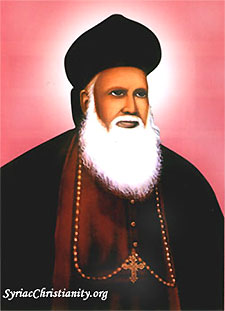 |
Mor Kurillos Geevarghese was born as the third child to the blessed parents Itty Mathu and Eli of Ambattu Vadakken family in 1010 M.E. (AD.1834-35). Mor Sabor Mor Aphroth Church at Akaparambu near Nedumbassery was his home parish. His ancestors originally belonged to Arthat in Kunnamkulam which is one of the oldest Syrian Christian settlement areas of Malankara. The family migrated to Poikkattussery in Angamali around the year 1789 when the King of Mysore, Tipu Sultan, attacked Kunnamkulam and tortured the Christian and Hindu communities living there. The ancestors of the Metropolitan who settled in the new place attained a respectable position in the society. Ayyampallil Mazhuvencheri Parambath Koruth, who was a Judge of the erstwhile State of Kochi was the maternal grandfather of the Metropolitan.
Metropolitan Ambattu Mor Kurillos who led the northern diocese of Angamali for almost 15 years had contributed a lot for the development of the diocese as well as the Church in the north. His Grace was very generous in using his ancestral property for the development of the Church.
Childhood days
Right from his childhood, Geevarghese alias Korath, as he was known, grew up in the fear of God. After completion of his primary education, he had his Syriac and theological studies under Kooran Karottuveettil Yakub Kathanar and Angamali Parackal Itty Mathen Kathanar. This was a period which helped the young boy to deepen his knowledge and conviction in the Syriac faith and traditions. Soon after, he was ordained as Deacon and later as Kassisso by the Patriarchal delegate Mor Kurillos Yuyakkim Bava (the exact year of these ordinations are not known). As a Kassisso he served his home parish, the Akaparambu Mor Sabor Mor Aphrot church untill his consecration as Metropolitan.
Patriarchal Visit
In AD 1876, the supreme head of the Church Patriarch Moran Mor Ignatius Pathros IV, came here on request of Malankara Church to find a longstanding solution to the crisis prevailing then in Indian Church. After solving the disputes with the British authorities, the Patriarch concentrated in the administrative restructuring of the Malankara Archdiocese. In June the same year, an historical Synod (Association) was convened at Mulunthuruthy under the auspices of His Holiness the Patriarch who suggested for the formation of six new dioceses in Malankara. It was also decided to confirm the lone Metropolitan from Malankara, H.G. Pulikottil Joseph Mor Dionysius, with the title 'Malankara Metropolitan' under whom six Metropolitans were decided to be ordained for each of the new dioceses. Several other important matters pertaining to faith, history and traditions of the Malankara Church were also discussed and approved by the Association. The historic meeting was attended by the representatives from various churches in Malankara.
Formation of Angamali diocese and the selection of a new Metropolitan
One of the six dioceses that was formed as per the decision of this Mulanthuruthy Synod was the diocese of Angamali. Angamali being the main centre of Malankara Syriac Christianity, always had a great importance in the history of the Church. It was also the largest of all the dioceses with respect to geographical area as well as the Syrian Christian population. When the issue of selecting a new Metropolitan for the diocese came, the representatives from the diocese unanimously proposed the name of Kassisso Geevarghese Ambatt and the Patriarch approved it without any hesitation.
On 27th June 1876 Kassisso Geevarghese was elevated as Ramban (Rabban – Monk Priest) at the Mulanthuruthy MarThoman Church by H.H. the Patriarch.
|
St.Mary's Jacobite Syrian Church at Angamali where the mortal remains of Metropolitan Geevarghese Mor Kurillos is interred |
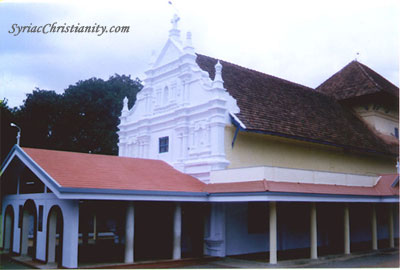 |
Metropolitan Consecration & the diocesan administration
On 10th December 1876 (Vrischikam 28) His Holiness Ignatius Pathros IV, consecrated Ramban Geevarghese Ambatt as Metropolitan for the Angamali diocese and was entrusted with the name MOR KURILLOS. The ceremony was held at the North Paravur St.Thomas church where St. Gregorios, the Metropolitan of Jerusalem is entombed in 1681. Chathuruthil Geevarghese Ramban (Parumala Thirumeni) was also ordained Metropolitan along with Ambatt Mor Kurillos on that occassion. It was only a week before, on 3rd December, Kadavil Paulose Mor Athanasius and Konatt Geevarghese Mor Julius were consecrated Metropolitans for the dioceses of Kollam and Thumbamon respectively by H.H. Patriarch, assisted by Metropolitans Pulikottil Mor Dionysius V and Mor Gregorious Abdulla (later Patriarch of Antioch Mor Ignatius Abded'Aloho II) in the same church. Later when Shemavun Mor Dionysius Karvattuveettil (Kochi) and Paulose Mor Sevarious Murimattam (Kandanad) were ordained Metropolitans on 17th May 1877, Ambattu Mor Kurillos and Chathuruthy Mor Gregorious had the privilege to assist the Patriarch in the Holy ceremony.
On 5th May 1877, H.H. the Patriarch of Antioch issued 'Susthathikon' to Geevarghese Mor Kurillos, entrusting him with the administrative charge of the Angamali diocese. At that time about 22 churches were under his direct administration in Angamali diocese. These were the churches at Angamali, Vaddakken Paravur, Akaparambu, Kuruppumpady, Kothamangalam, Pallikkara, CheriaPally and ValiyaPally at Kothamangalam, Thuruthipply, Rakkad, Manjapra, Peechanikadu, Kottappadi, Mazhuvannur, Karakunnam, Pothanikad, Chelad, Vengoor, Kunnakkurudy, Kadathi, Allapra and Marady.
|
Madbho of the Angamali Morth Mariam Church |
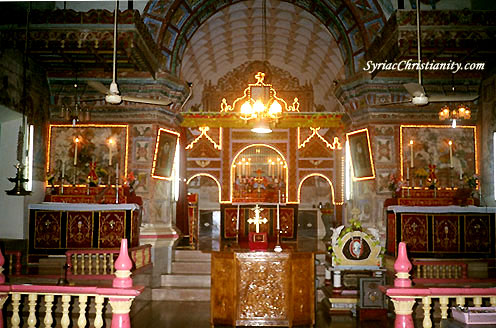 |
Ambattu Thirumeni’s service for the Angamali diocese and the Malankara Church as a whole is highly commendable and is a matter to be recalled by all. Under his able guidance many new parishes were organised. A number of Priests were ordained by His Grace. Since there was no specific diocesan centre in those days, the Metropolitan administered the diocese staying at different places, mostly at Kothamangalam, Kuruppumpady and Rakkad churches. Unlike the situation in the southern dioceses where a great number of faithful had an inclination towards the new teachings of the protestant missionaries, those in North (except in parts of Kunnamkulam) strictly followed the Holy Apostolic faith of the Syrian Church. Ambattu Thirumeni’s work among the masses, helped to avert even the slightest possibility of such threats by Protestants in Angamali diocese.
It was under the initiative of Ambattu Mor Kurillos, the land at Thrikkunnathu (Aluva), where a Jacobite Syrian Christian Seminary was later started by his successors, was brought. The construction work of the Morth Mariam church there was started in 1055 (AD 1889-90). On 2nd March 1899 (1064 Kumbam 18), Ambatt Mor Kurillos Thirumeni consecrated the partially completed Morth Mariam church and celebrated the first Holy Qurbono. Ambatt Thirumeni was kind enough to donate a large amount for the construction of this church building.
Passing away
During a visit to Pambakuda church in 1891, His Grace became sick all of a sudden and had to return to his parish at Akaparambu. Even before he fell ill, a 'Qabar' (burial place for a bishop) has been constructed on the northern side of the Angamali church as per his will. His health deteriorated very soon, however he was fully conscious until he breathe his last.
On Sunday, 9th March 1891 (M.E- 1066 Kumbham 24), at around 8 in the evening, Ambatt Geevarghese Mor Kurillos passed away. Thirumeni was only 56 years at the time of his demise. His body was laid to rest at the Angamali Jacobite Syrian Church as per his last wishes.
|
Tomb of Ambatt Mor Kurillos Thirumeni at the Morth Mariam Jacobite Syrian Church, Angamali |
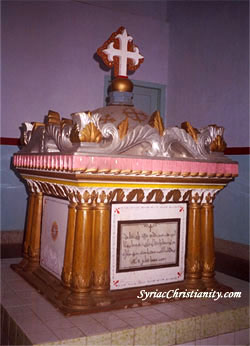 |
|
Syriac & Malayalam Inscriptions at the Tomb of Ambatt Mor Kurillos Thirumeni |
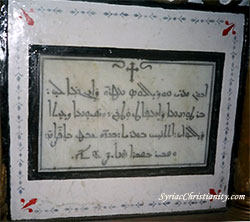 |
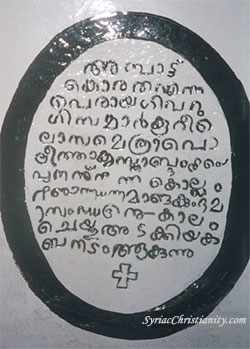 |
Prelates who succeeded Ambatt Geevarghese Mor Kurillos
After the demise of Ambatt Thirumeni, Paulose Mor Athanasius Kadavil the then Metropolitan of Kottayam diocese was given the additional charge of Angamali diocese also. The construction work of the Thrikkunnathu St. Mary's church was completed during his time. It was Kadavil Thirumeni (1876-1907) who laid the foundation for a Jacobite Syrian Christian seminary at Thrikkunnathu. In 1910 St. Athanasius Paulose Painadath (popularly known as Valiya Thirumeni) was ordained as Metropolitan for the Angamali diocese. He later become the Malankara Metropolitan (1918-'53) and head of the Malankara Church. It was Valiya Thirumeni who constructed the Thrikunnathu Seminary building and developed its premises, mostly with his own money, raised through the selling of his ancestral property at Akaparambu. Nearby Thrikkunnathu St.Mary's church was also reconstructed by him during this period. On 26th January 1953 the holy father passed away and was laid to rest at the Thrikkunnath St.Mary's church. Later Vayaliparambil Geevarghese Mor Gregorios assumed the charge of the Angamali diocese as its fourth Metropolitan. He served the diocese till his demise in 1966.
For the ancient Mor Sabor Mor Aphroth Church at Akaparambu, it is a matter of great pride that it has given four successive Metropolitans for the Malankara Church; Ambatt Mor Kurillos, Kadavil Paulose Mor Athanasius, Painadath Paulose Mor Athanasius and Vayaliparambil Geevarghese Mor Gregorios, in just about seventy five years time period. Among them the former Malankara Metropolitan St. Athanasius Paulose Painadath (popularly known as Valiya Thirumeni), the disciple of the Ambatt Mor Kurillos Thirumeni, is one of the most popular and venerated primate of Malankara Church. From childhood Valiya Thirumeni was patronized by Ambatt Mor Kurillos Thirumeni. It was Ambatt Thirumeni who ordained St. Athanasius Paulose a Deacon at the tender of age of 10, in April 1879.
|
Inscription in front of the Angamali Church |
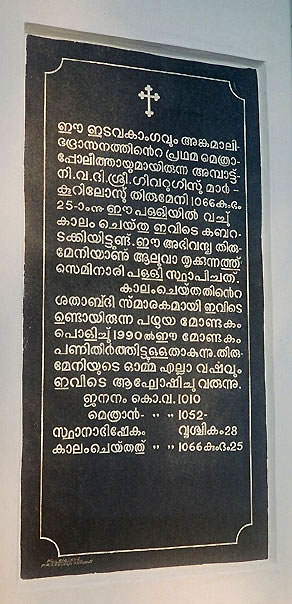 |
Main Source:
Varghese John Thottapuzha, Biography of Ambatt Thirumeni published in the 'Journal of Kottayam Diocese'.
Other References:
Very Rev. Kurien Corepiscopa Kaniamparambil, 'Aluvayile Valiya Thirumeni' (Biography of Malankara Metropolitan Paulose Mor Athanasius, 1954);
Souvenir of the Angamali Church.